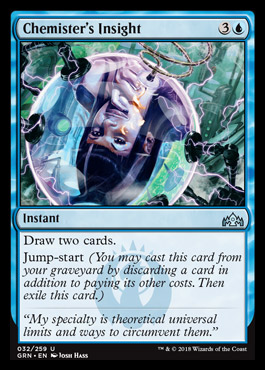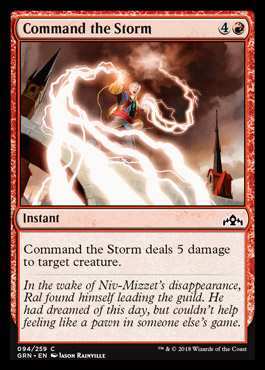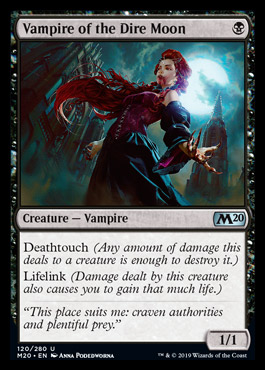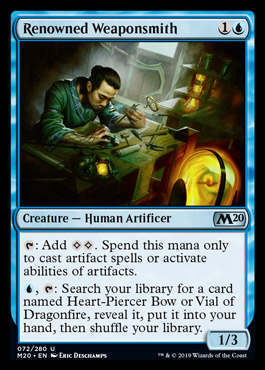
I love magic coaching.
It’s the perfect marriage of my two passions,
teaching, and playing with 63 x 88 mm pieces of cardboard.
Having the past few weeks off work, I’ve been fortunate enough
to be able to sneak in more coaching sessions than I usually can during the
school year. At the beginning of each session, I like to ask
the coachee a little bit about their magic background in order to set
a baseline of who they are as a player. The questions vary from
session to session, but to ensure I can give can give actionable
advice, there’s one question that I make sure to ask to every person:
“What do you think your biggest leak or weakness is
when it comes to limited?”
In the overwhelming majority of cases, the answer that I
receive is something along the lines of:
“Well, I think I have a pretty good grasp on card evaluation, but I feel like at the end of the draft I end up with a pile of good cards rather than a deck.”
“Well, I think I have a pretty good grasp on card evaluation, but I feel like at the end of the draft I end up with a pile of good cards rather than a deck.”
If you can relate to that statement, I can promise you
aren’t alone.
On virtually every outlet where you can consume magic
content (Discord, Reddit, Twitter, Youtube,
Tinder? etc.) you can find similar sentiments:
“Draft started out strong, but fell apart by the end”
“Draft started out strong, but fell apart by the end”
“P1P1 took X bomb rare, but not sure where to take the draft now”
“Middle of pack two and I have no idea how to salvage the rest of this
draft, pls send help”
Today I want to explore why I think this is a commonly shared experience, and
what you can do to bridge the gap between good card
evaluation skills and good drafting/deck building skills.
In short, I want to explore how to draft a deck, not a pile
of good cards.
Content Creation and Our Focus on Card Evaluation


For the most part, limited content and community
discussion revolves around baseline card evaluation, card grading. Week 0 of a format is when content
producers put out set reviews grading each card, week 1-2 is
when the info dump of over/under-performers start to trickle
in, week 3 is about the time when people have figured out where
the rares and mythics sit in relation to the commons
and uncommons and at week 4+ there is still
no slowdown of “P1P1 which card is better” on Twitter and Reddit
Is it bad that content creation and community discussion is mostly focused on baseline card evaluation and card grading?
Is it bad that content creation and community discussion is mostly focused on baseline card evaluation and card grading?
No! In fact, I think it’s great.
There was time when access to accurate card
evaluation information was semi-restricted to people who had the time
to put in 30 drafts in the first two weeks or were in the know with people who
had. Without a prior of accurate baseline card evaluations, its near
impossible to draft anywhere close to optimally or to construct an accurate
idea of what is important in each format. Card evaluation is one
of the pillars of limited and without set reviews and endless online
discussion, we may still be in the dark ages of people passing cards like
Bag of Holding or Rotting Regisaur on day two of a GP
because they look like weird cards to someone who hasn’t the
time for 30 drafts before the first competitive event of a format.
As a community in the year 2019, we have a
great collective grasp on card evaluation. Anyone who wants
to double check their own baseline card evaluations/card
rankings can listen to the latest episode of their favorite podcast,
tweet at their favorite limited specialist, or tune into an MPL member’s
stream. We live in a time where access to accurate card gradings are
available on demand to anyone who wants them.
So where is the disconnect?
In a world where card learning evaluations
skills are part of limited 101 and you can
crowd-source opinions from the literal best players in the
world, what makes picks 2 through 45 seemingly infinitely harder than pick
1?
I believe that due to the sheer volume of content and discussion
around baseline card evaluations/ card grading, a lot of players get bogged down
in the minutia of it all. There seem to be endless “is this B- card better than
this B- card?” conversations, and while yes, there is usually a correct and
incorrect answer, the real answer is early in the draft the cards are probably close
enough that its hard to go wrong and later in the draft it depends on the context
of your previous picks.
Teaching how to adjust or contextualize baseline evaluations
to facilitate drafting a functional deck is a skill that doesn’t get it’s time
in the sun.
Let’s Revisit Our Initial Question: How do you Draft a Deck, Not a Pile of Good Cards?


For me, drafting a deck instead of a pile of good cards can
be distilled down to two things:
1. Understanding baseline card grades/evaluations
2. Modifying those grades/evaluations based on context for
every pick of the draft
You must internalize that card grades, baseline card
evaluations are just that. Baselines. After you’ve begun to carve out/
find your lane, your goal is no longer to identify the best card in
the pack, it’s to make picks that serve the deck you’re drafting.
This isn’t a new concept but it may be for some
readers, but I think it certainly bears repeating. After
P1P1, sometimes as early as P1P2, grades and pick orders change
based on your previous picks.
Sometimes this change is by just a hair,
sometimes more dramatically. Early in the draft you should weight
your picks towards the best cards in the pack until you can find your lane,
but once that lane is found every pick you make should be informed by your previous
picks and should contribute towards filling a role in your deck. There are
times when you’re going to take Reduce to Ashes over Glint-Horn
Buccaneer and Sleep Paralysis over Atemsis because that’s what
your deck needs to function. If you catch your self auto-picking the best card
in the pack for all of pack 2, you’re probably losing some amount of percentage
points.
Using Pick Orders/Card Grades
1. Using pick orders or card grades to take the best card
from every pack in the first few picks is totally fine and helps alleviate decision
paralysis. Rely on them less later in the draft when context is more important than ranking each
card in a vacuum.
2. Before you can use context to modify your baseline card
evaluations, you need to be confident that you have solid estimation of where
every card in the set stands. This is the easy part. As previously mentioned,
there are countless outlets for you to cross
reference you own card evaluations. Talk to players whose opinions you trust, send
a tweet to your favorite content creator if you are unsure how good a card is in
each format, ask the best player at your LGS. Don’t be shy about double
checking, if there’s anything magic players love, it’s telling other people their
opinions.
3. Make sure your baseline evaluations are up to date and
are from informed sources. When I say “informed sources” I don’t mean “don’t
ask bad players”, I mean consult sources that have of experience playing with
the cards and know how the cards play in context.
LSV’s set reviews are great as starting points, but even he will tell you that
3 months into the format you shouldn’t treat them as gospel. Any set review put
out before a set’s is going to be obsoleted to some degree after people get
their hands on the cards. The only place to get contextually accurate card
evaluations is from sources who have had hands on experience with the cards.
4. It’s ok to have a dissenting opinion on a card evaluation
when compared to the masses. Drafting with preferences is something I strongly advocate
for and as long as you can verbalize and rationalize why you disagree on the consensus of a card, there is no issue.


As an example, I’m a notch lower than the rest of the world
on Leafkin Druid. I recognize the card is great and green is a colour that
wants to ramp most times, but I don’t take
it as highly as most people because my green decks tend to lean towards aggression.
This causes my baseline evaluation of Leafkin Druid to be lower than most other people and it
takes additional incentive for me to take Leafkin Druid over Rabid bite.
Modifiers
to Your Baseline Card Evaluations
Here’s where the grading cards in context comes in. Ideally
you are incrementally modifying your picks based on the context of each pack
and your picks but be aware that you will mostly want to modify your
evaluations:
A: Later in the draft when you have an idea what your deck needs
B: Early in the draft when a pick is close (as a basic example, you first pick Cavalier of Flame so you take Chandra’s Outrage over Murder P1P2)
Here are some common pick order modifiers that you can put
into practice.
Modifying Grades Based on Archetypes
It's important to know what cards each archetypes want and what cards they don't. Many formats have "secret gold cards" cards, mono-colored cards that really only belong in one or two colour pairs. This is more common in high synergy formats that have decks that want to be linear or more streamlined. Most Ravnica sets are a pretty good example of this.
It's early in pack 2 and you're solidly in Izzet



You're faced with the choice between these two cards so you check their grades


C+ C
If you took bodyguard in this spot because its "the best card in your colors" you'd be making a reasonably bad pick. Most Izzet decks in GRN ended up with sub-13 creatures making Wojek Bodyguard a liability. While a worse card early in the draft, Command the Storm is a better pick in this spot because of how linear GRN archetypes were.
This concept applies to low-medium synergy sets as well, but picking the "wrong" card won't be as punishing.
We're in the middle of pack 2 of a M20 draft and you're solidly in UB control



You're faced with the pick between these two cards


C+ C+
I consider Audacious Thief to be the slightly better card P1P1 but would take Vampire in this spot. With the cards I have in my pile, i'm less likely to include cards in my deck that facilitate attacking profitably with the Thief . However, unlike the GRN example, I don't think it would be an egregious mistake to take Thief. While your UB deck has a generalized plan, M20 decks usually aren't so focused that they can't make uses of generically good cards that don't quite fit their plan.
The takeaway here is that you should have a good understanding of how synergistic/linear decks in a given format are and know how heavily to weigh picks based on what archetype you're in. In high synergy formats slight discrepancies in grades between cards can be amplified and taking a card that is not conducive to what your deck wants to do can be punishing.
Modifying Grades Based on Pockets of Synergy
"Pockets of synergy" is a term I like to use to describe groups of cards that have high synergy with each other in an otherwise low synergy deck. Drafting pockets of synergy is a way to boost the overall power-level of your deck when you don't get the nuts GR elemental deck or don't end up with 3 great rares.
M20 is home to one of my favorite pockets that I affectionately call the Fantastic 4




Most of these cards are fine on their own, but when you have say two copies of each in your deck, they give your deck a dimension other than "good cards in my colour." Drafting pocket of synergy is one of the key ways that you can draft a deck, not just a pile of good cards.

Renowned Weaponsmith + Bow/vial is another great example of a pocket of synergy, but with I challenge you to look even further than the obvious synergies written on the card. With enough copies of Weaponsmith, you can extend this (make you pocket bigger??) by including cards that normally wouldn't make your main deck but become actively good when you can reliably have a Weaponsmith.


Let's say its Pack 3 and you're an aggressive red black with three Chandra's Outrages and two Lavakin Brawlers among your other cards.





You're faced with this pick, Outrage vs your first Chandra's Ember cat


B+ C
There is a huge discrepancy in P1P1 power-level here, but I'm just taking Embercat almost every time here. You just don't need to take the Outrage here, the fourth copy doesn't facilitate your aggressive plan better than Embercat potentially casting turn three Lavakin Brawler. Removal is great but there is 100% a such thing as too much removal, and you want to draft a deck that is greater than the sum of its parts.
Modifying Grades Based on Two-Card Interactions There is a huge discrepancy in P1P1 power-level here, but I'm just taking Embercat almost every time here. You just don't need to take the Outrage here, the fourth copy doesn't facilitate your aggressive plan better than Embercat potentially casting turn three Lavakin Brawler. Removal is great but there is 100% a such thing as too much removal, and you want to draft a deck that is greater than the sum of its parts.
This is similar to pockets of synergy, just on a smaller scale. When you have Destructive Digger or maybe Renowned Weaponsmith in your pile, consider picking up that 10th pick Retributive wand, as it's worth putting slightly conditional cards in your deck in exchange for powerful two card interactions.


Mask of Immolation and Act of Treason is another good example of this


Knowing a formal rather intimately is rewarded here. Getting familiar with the cards in each format means you'll be more aware of interactions like this, and you'll have a good sense of when it's worth putting a card like Wand or Act of Treason in your deck. There are times when you see cards that may look like they fit this description but just end up being traps.
Filling
in Holes in Your Deck
The two most common holes that need to be filled are a need for interaction, and a need to lower your curve. Once you're late into pack 2 or opening pack 3, baseline grades nearly go out the window if you have holes in your deck that needs to be filled. As I mentioned before, there are times when you’re going to take Reduce to Ashes over Glint-Horn Buccaneer and Sleep Paralysis over Atemsis because that’s what your deck needs to function.
Let's look at this pick from pack 3 of this aggressive RW draft

Both Lavakin Brawler and Scampering Scorcher are markedly better cards than Chandra's Embercat but in this spot I'm taking the cat. We already have a ton of 4's already and would like to enable turn three Lavakin Brawler.
Here's another example except this time, we're choosing between a removal spell and a great creature.

If I was leaning towards UB early in the draft and was faced with this pick, I'd take Tomebound Lich over Murder. However, at this point in the draft we've already got a bunch of quality creatures and are in desperate need of another piece of interaction. I honestly think if the pick here were between Murder and Cavalier of Gales, I'd take the Murder. We have good top end and upgrading our finishers doesn't do as much for this deck as adding another removal spell.
Takeaways
- To successfully draft a deck and not a pile of good cards, you need to keep your pick order fluid
- Always be re-evaluating your picks and contextualizing cards based on what you already have
- Be smart about pick orders, they're a great tool, but use them as baselines, not absolutes
- Look for pockets of synergy to draft a deck that's greater than the sum of its parts
- To make the most informed picks, educate yourself about the format so that you are cognizant about archetypes and card interactions
- You should be deck building as you draft. You don't want to end up in a spot where at the end of the draft you have a pool of cards and go "ok now how do I build this?" outside of changing cards 20-23
Thanks for reading !

An excellent, excellent article that really explains *and* gives examples about the subject matter. Thanks!
ReplyDeleteThe use of examples really sells some things I thought I knew, but the concept of "pockets" is really insightful.
ReplyDeleteThank you! Examples are critical! I learn a lot from watching youtubes or streams, I am definitely too new to find these pockets on my own.
ReplyDeleteThis comment has been removed by the author.
ReplyDeleteThanks for sharing such an amazing blog. It is really helpful for me and I get my lots of solution with this blog
ReplyDeleteOnline building design
I never believed that their could be a complete cure for herpesvirus, i saw people’s testimony on blog sites and comment section about Robinson Buckler a herbal doctor and the efficiency of his herbal medicine.I had to give him a try because i my self have been suffering from the same virus, and i was not disappointed. It took just few weeks i started using it i started noticing changes. I was cured . You can also contact him on his email:___________________________ robinsonbuckler {@} yahoo . com 😂
ReplyDelete(You can also place your order if you wish)🥰🥰
(I hope this helps)😃😃
Kind Regards
Very good website, thank you.
ReplyDeleteOdia Book Hida Mati
Order Odia Books
Odia Books Online